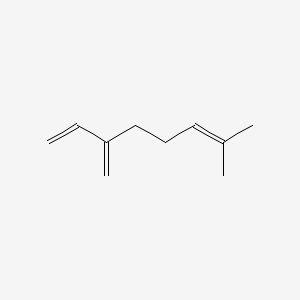| Authors | Title | Published | Journal | PubMed Link |
|---|---|---|---|---|
| Wigglesworth VB | Lipid staining for the electron microscope: a new method. | 1975 | J. Cell. Sci. | pmid:54360 |
| Van Poecke RM et al. | Herbivore-induced volatile production by Arabidopsis thaliana leads to attraction of the parasitoid Cotesia rubecula: chemical, behavioral, and gene-expression analysis. | 2001 | J. Chem. Ecol. | pmid:11710601 |
| Omura H et al. | From terpenoids to aliphatic acids: further evidence for late-instar switch in osmeterial defense as a characteristic trait of swallowtail butterflies in the tribe papilionini. | 2006 | J. Chem. Ecol. | pmid:16902823 |
| Martini A et al. | The influence of pine volatile compounds on the olfactory response by Neodiprion sertifer (Geoffroy) females. | 2010 | J. Chem. Ecol. | pmid:20809142 |
| Kigathi RN et al. | Emission of volatile organic compounds after herbivory from Trifolium pratense (L.) under laboratory and field conditions. | 2009 | J. Chem. Ecol. | pmid:20013039 |
| Sandstrom P et al. | Myrcene hydroxylases do not determine enantiomeric composition of pheromonal ipsdienol in Ips spp. | 2008 | J. Chem. Ecol. | pmid:19034575 |
| Paris CI et al. | Changes in monoterpene emission rates of Quercus ilex infested by aphids tended by native or invasive Lasius ant species. | 2010 | J. Chem. Ecol. | pmid:20549328 |
| Opitz S et al. | Increased terpenoid accumulation in cotton (Gossypium hirsutum) foliage is a general wound response. | 2008 | J. Chem. Ecol. | pmid:18386096 |
| Karr LL and Coats JR | Effects of four monoterpenoids on growth and reproduction of the German cockroach (Blattodea: Blattellidae). | 1992 | J. Econ. Entomol. | pmid:1593013 |
| Skiri HT et al. | Associative learning of plant odorants activating the same or different receptor neurones in the moth Heliothis virescens. | 2005 | J. Exp. Biol. | pmid:15695769 |
| Aros D et al. | Volatile emissions of scented Alstroemeria genotypes are dominated by terpenes, and a myrcene synthase gene is highly expressed in scented Alstroemeria flowers. | 2012 | J. Exp. Bot. | pmid:22268153 |
| Yvon Y et al. | Relation between chemical composition or antioxidant activity and antihypertensive activity for six essential oils. | 2012 | J. Food Sci. | pmid:22860587 |
| Hughes PR | Myrcene: a precursor of pheromones in Ips beetles. | 1974 | J. Insect Physiol. | pmid:4853305 |
| Abbasipour H et al. | Fumigant toxicity and oviposition deterrency of the essential oil from cardamom, Elettaria cardamomum, against three stored–product insects. | 2011 | J. Insect Sci. | pmid:22242564 |
| Sõukand R et al. | Uninvited guests: traditional insect repellents in Estonia used against the clothes moth Tineola bisselliella, human flea Pulex irritons and bedbug Cimex lectularius. | 2010 | J. Insect Sci. | pmid:21070174 |
| Baik JS et al. | Chemical composition and biological activities of essential oils extracted from Korean endemic citrus species. | 2008 | J. Microbiol. Biotechnol. | pmid:18239420 |
| Lee JH and Hong SK | Comparative analysis of chemical compositions and antimicrobial activities of essential oils from Abies holophylla and Abies koreana activities of essential oils from Abies holophylla and Abies koreana. | 2009 | J. Microbiol. Biotechnol. | pmid:19420993 |
| Lee JH et al. | Chemical composition and antimicrobial activity of essential oil from cones of Pinus koraiensis. | 2008 | J. Microbiol. Biotechnol. | pmid:18388468 |
| Utrilla MP et al. | Santolindiacetylene, a polyacetylene derivative isolated from the essential oil of Santolina canescens. | 1995 | J. Nat. Prod. | pmid:8594153 |
| Perrucci S et al. | Structure/activity relationship of some natural monoterpenes as acaricides against Psoroptes cuniculi. | 1995 | J. Nat. Prod. | pmid:7595592 |
Myrcene
Myrcene is a lipid of Prenol Lipids (PR) class. Myrcene is associated with abnormalities such as Hypomenorrhea, abnormal fragmented structure, Nephrosis, Renal tubular disorder and Kidney Diseases. The involved functions are known as Anabolism, Gene Expression, Protein Biosynthesis, Mutation and Selection, Genetic. Myrcene often locates in Plastids, Proboscis, Body tissue, Clone and soluble. The associated genes with Myrcene are TTPA gene, monoterpene synthase, Genome, 4S-limonene synthase and Homologous Gene. The related lipids are Pinene, Octanols, Membrane Lipids and Fatty Acids, Unsaturated.
Cross Reference
Introduction
To understand associated biological information of Myrcene, we collected biological information of abnormalities, associated pathways, cellular/molecular locations, biological functions, related genes/proteins, lipids and common seen animal/experimental models with organized paragraphs from literatures.
What diseases are associated with Myrcene?
Myrcene is suspected in Nephrosis, Kidney Diseases, Dehydration, Hypomenorrhea, Renal tubular disorder and other diseases in descending order of the highest number of associated sentences.
Related references are mostly published in these journals:
| Disease | Cross reference | Weighted score | Related literature |
|---|
No disease MeSH terms mapped to the current reference collection.
PubChem Associated disorders and diseases
What pathways are associated with Myrcene
There are no associated biomedical information in the current reference collection.
PubChem Biomolecular Interactions and Pathways
Link to PubChem Biomolecular Interactions and PathwaysWhat cellular locations are associated with Myrcene?
Visualization in cellular structure
Associated locations are in red color. Not associated locations are in black.
Related references are published most in these journals:
| Location | Cross reference | Weighted score | Related literatures |
|---|
What functions are associated with Myrcene?
Related references are published most in these journals:
| Function | Cross reference | Weighted score | Related literatures |
|---|
What lipids are associated with Myrcene?
Related references are published most in these journals:
| Lipid concept | Cross reference | Weighted score | Related literatures |
|---|
What genes are associated with Myrcene?
Related references are published most in these journals:
| Gene | Cross reference | Weighted score | Related literatures |
|---|
What common seen animal models are associated with Myrcene?
There are no associated biomedical information in the current reference collection.
